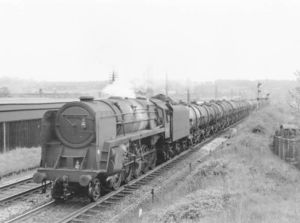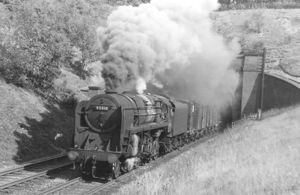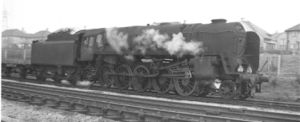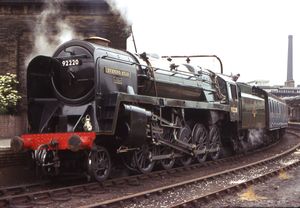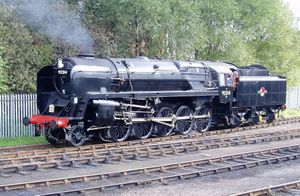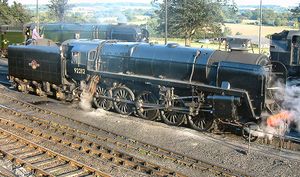BR standard class 9F
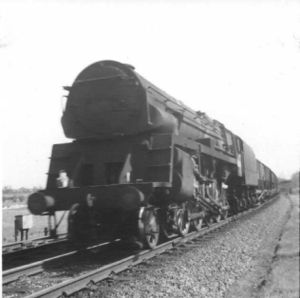
The British Railways Standard Class 9F 2-10-0 is a class of steam locomotives, and the last steam locomotive design built by British Railways. 251 locomotives were built, numbered 92000-92250. Many lasted only a few years in service before withdrawal as steam traction was ended on the mainline in Britain.
Contents
Background
On nationalisation in 1948, British Railways had a number of heavy freight locomotives that had been built to aid the war effort. It had 666 LMS 8F class 2-8-0, numerous WD Austerity 2-8-0s and WD Austerity 2-10-0s. New heavy freight locomotives were thus not a priority.
The original proposal was for a boiler from the Standard Class 7 Britannia 4-6-2 to be combined with a 2-8-2 wheel arrangement. However it is thought that R.A. Riddles preferred the 2-10-0 arrangement, as used on his Austerity 2-10-0s. The firebox had to be slightly reduced in size from the Britannias as a result. The 5' 0" driving wheels lacked flanges on the centre axle and had reduced ones on the second and fourth.
The 9F turned out to be the best of the standard designs, and arguably one of the finest steam locomotive designs ever. It was highly effective at its designed purpose, hauling heavy, fast freight trains, and was used all over the British railway network. In 1983, preserved engine 92203 Black Prince set the record for the heaviest train ever hauled by a steam locomotive in Britain, when it started a 2,162-ton train at a Foster Yeoman quarry in Somerset, UK.
The 9F also proved its worth as a passenger locomotive, adept at fast running despite its small driving wheels. One one occasion, a 9F was set to haul an express passenger train from Grantham to King's Cross. An enthusiast aboard the train timed the run and noted that twice the speed exceeded 90mph. Evidently, the driver was afterwards told that he was only supposed to keep time, "not break the bloody sound barrier!" He replied that the engine had no speedometer, and that it ran so smoothly at high speeds that he just let it run as fast as felt safe. Nor was this the only instance of 9Fs reaching high speeds. However, concerns that the high rotational speeds involved in fast running could cause excessive wear and tear to the running gear prompted management to put a stop to the use of 9Fs on express trains [1]
Variations
The 9F was used as a proving ground for a variety of technical innovations. All were promised to provide improvements in efficiency, power or cost.
92020-92029 were built with Franco-Crosti boilers. An additional boiler ran under the main boiler, taking the firebox gases back from the smokebox to a chimney on the right side of the locomotive forward of the cab. The standard chimney at the front was only used during lighting up. The additional boiler acted as a pre-heater, using low-grade heat that would otherwise be wasted. However, the experiment did not deliver the hoped-for benefits. Efficiency was not increased sufficiently to justify the cost and complexity. The locomotives were unpleasant on the footplate in a cross-wind and the low temperature of the gases in the secondary smokebox caused serious corrosion due to the formation of sulphuric acid. The engines were rebuilt without the Franco-Crosti boiler, although they retained some of their distinctive looks.
92165-92167 were built with a mechanical stoker. A helical screw conveyed coal from the tender to a plate in the firebox, where four steam pipes directed coal evenly across the grate. The powered stoker made higher steaming rates possible, though with an accompanying loss of efficiency. It was hoped that mechanical stoking might enable the burning of low-grade coal but this proved to be unsuccessful. Simply supplying more low grade coal than a fireman could do by hand did not provide stable burning.
92250 was built with a Giesl blast pipe and chimney. This offered the same level of draught for a reduced level of exhaust back-pressure or, alternatively, increased draught with no performance loss elsewhere. The exhaust gases were progressively fed into the smokebox gases through a succession of nozzles, rather than by a single blast pipe. Again, great claims were made as to the potential benefits, but these did not emerge either on test plant or in service. 92250 retained the variant blastpipe until withdrawal, but no benefit was noticeable. The burning of low-grade coal was again held out as a potential benefit, a benefit which was not delivered.
The only modification which did deliver any noticeable benefit, albeit a marginal one, was the fitting of all 9Fs from 92178 onwards with double blastpipes and chimneys. This allowed the engines to steam slightly more freely and thus generate higher power ranges. In everyday service it made no great difference.
Riddles and his team had got the 9F right first time. Once a few teething problems had been rectified, it proved highly effective and extremely reliable.
92220 Evening Star
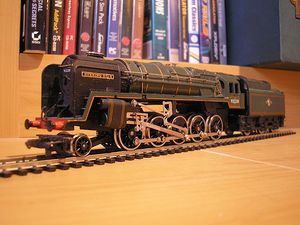
In 1960, 92220 Evening Star, although not the highest numbered, became the last steam locomotive to be built by British Railways. To mark this, she was named and given a green passenger livery, as opposed to the unlined black normally given to freight locomotives, and a copper-capped chimney.
Evening Star was always treated as something of a special engine and was frequently used for special trains. During the summer of 1960 it was used on the "Capitals United" expresses between London and Cardiff. Its status as the last steam locomotive to be built by BR earmarked it for preservation, and on withdrawal in 1965 it was placed in the National Collection. Evening Star was returned to steam in the early 1980s and was regularly used on railtours.
Preservation
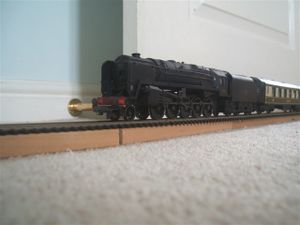
Nine 9Fs have survived, these being 92134, 92203 Black Prince, 92207, 92212, 92214, 92219, 92220 Evening Star, 92240 and 92245.
In fiction
An example of this type of locomotive can be seen on the Thomas the Tank Engine and Friends TV Series. The character's name is Murdoch the Heavy Goods Engine, who, despite his size and strength, enjoys peace and quiet in 'Murdoch's Peace and Quiet'.
External links
| British Railways standard classes: |
|
Britannia Class 7 |
Duke of Gloucester |
Clan Class 6 |
5MT 4-6-0 |
4MT 4-6-0 |
- ↑ H.C.B. Rogers, Riddles and the 9Fs (Ian Allan, 1982)
